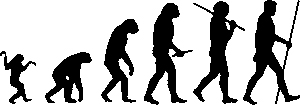Jacobs bats away evolutionary fallacies
18 October 2016 | Story Yusuf Omar.
A Batman figurine lurks in the shadows of Associate Professor David Jacobs' office in UCT's zoology building. But it's not for reasons of secrecy that he's reluctant to be photographed with the caped crusader.
We're there to speak about Evolution's Chimera. Jacobs' new book uses bats – chimeras of the natural world, with reptilian-like wings, furry bodies and gargoyle faces – to explain evolutionary staples like competition and predation.
The book is not about bats, per se, he says, despite the striking image on the cover. It's more about using bat biology, including their superior flying ability and eternal battles with moths, to illustrate a topic that Charles Darwin hoisted into the public consciousness.
As an appetiser, Jacobs clears up a common misconception about evolution.
“In my experience, the two most misunderstood topics happen to be the ones I am interested in – bats and evolution,” he says. “You heard one of our ministers rejecting evolution because they refused to believe that they came from an ape. This is a commonly held view about evolution, but it represents a fundamental misunderstanding of what evolution says about human origins.”
Evolution theory does not suggest that we come from apes at all.
“It suggests that we share a common ancestor way back. This is very different from saying we evolved from apes, giving people the impression that today's apes are going to evolve into humans in the future. Evolution is too unpredictable for us to make such claims.
“The randomness of the process means that the chances of, say, today's chimps evolving into humans in a few thousand years is highly improbable.”
Predictably unpredictable
Jacobs emphasises that randomness is a key component of evolution.
“I use bats to show how variation comes about because evolution is based on variation. In any natural population, no two individuals are alike. That's what I mean by variation,” Jacobs says.
It is the generation of that variation, for example through mutation, that is random.
“They have different capacities to reproduce and survive, and because of those different capacities they contribute different numbers of offspring to the next generation,” he explains. “When that happens, you have a change in the population from one generation to another. That's what evolution is.”
Take the relationship between echolocation and mating, for instance. Bats are said to have evolved sonar to hunt in complete darkness, and new research suggests that they also use it to communicate.
They emit a complex range of sounds, which includes harmonics that differ in frequency. Horseshoe bats' ears, for example, are tuned to pick up the “second harmonic”, but they are mostly deaf to other harmonics, says Jacobs.
If a mutation arose in one or more horseshoe bats that shifted their hearing capacity to, say, the third harmonic, they would no longer be able to hear bats that still used the second harmonic. This process is known as harmonic hopping.
“If echolocation is used in communication and in mate choice, for example, then bats of the same species with the mutation for hearing sensitivity at the higher harmonic will not be able to hear bats still sensitive to the lower harmonic. The two groups of bats will no longer recognise each other as potential mates, leading to assortative mating and lineage diversification,” Jacobs explains.
Harmonic hopping is just one example of lineage diversification that Jacobs details in the book.
 Cartoons like this one cause confusion about evolution because they erroneously suggest that today's chimps will evolve into tomorrow's humans, says Assoc Prof David Jacobs. Photo José-Manuel Benitos via Wikimedia Commons.
Cartoons like this one cause confusion about evolution because they erroneously suggest that today's chimps will evolve into tomorrow's humans, says Assoc Prof David Jacobs. Photo José-Manuel Benitos via Wikimedia Commons.
What fuels evolution?
Evolution's Chimera also explains how competition and predation fuel evolution – are moths and bats engaged in an evolutionary arms race, for instance?
Spoiler alert: Jacobs says no, contrary to what many of his colleagues argue. He also dismisses the idea of universally superior traits when it comes to natural selection.
“You can't talk about universally superior traits, even when you're talking about intelligence, because we can have an argument about whether intelligence has made us successful or not. We can claim that at the moment it has, but look at what we're doing to our environment.
“So, ultimately, that intelligence doesn't give us the will to do what is needed to avoid this destruction of our habitat. Ultimately, our intelligence could be our demise, right?
“Everything is context-dependent. Whether a trait is good or not is determined entirely by the habitat context.”
Having a long neck like a giraffe when all of the food is low down is disadvantageous, he says. Move that same giraffe to another habitat where all the food is in the treetops, and the long neck becomes an advantage.
Within a habitat there will be some traits that are 'better' than others because it allows the bearer of that trait to survive and reproduce in that particular habitat.
“Those are the kind of elements of evolution that people really get mixed up.”
Demystifying complex critters
It's not just evolution that is easily misunderstood; there are lots of superstitions around bats themselves, says Jacobs.
While bats are omens of bad luck across the world, there are some glaring exceptions.
“In China they are actually a symbol of luck,” he says. “In Central America the Mayans believed that the afterlife is in the earth somewhere, and the caves are entrances to that afterlife. What you see in caves are bats, so they actually believe that bats are kind of angels, guarding the afterlife.”
It's his passion for bats, evolution and teaching that inspired Jacobs to write the book. He aims it at everybody vaguely interested in evolution and bats and hopes that high school teachers will use it as a teaching aid and to boost their own understanding of evolution.
“I've put in a lot of effort to make it accessible to as many people as possible. So the language I use is everyday language. I steer clear of scientific jargon. Where I do mention scientific terms, I've provided explanations in the form of a glossary. So I'm hoping that from high school onwards, people will find a use for this book.”
 This work is licensed under a Creative Commons Attribution-NoDerivatives 4.0 International License.
This work is licensed under a Creative Commons Attribution-NoDerivatives 4.0 International License.
Please view the republishing articles page for more information.










